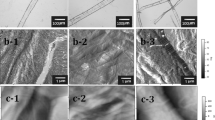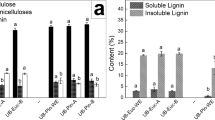Abstract
Biodegradability, renewability and high specific strength properties of cellulose nanofibres and microfibrils have made them very attractive in nano-biocomposite science. Treatment of natural fibers with suitable enzymes or fungus has been found to substantially alleviate the high energy requirement associated with the isolation of cellulose nanofibers via high shear refining and subsequent cryocrushing. This article briefly describes a novel enzymatic fiber pretreatment developed to facilitate the isolation of cellulose nanofibres and explores the effect of pre-refining of fibers on the effectiveness of bio-treatment. Soft wood Kraft pulp was pre-sheared to different degree and treated with a genetically modified fungus isolated from fungus infected Dutch elm tree. Cellulose nanofibres were isolated from these treated fibers by high shear refining. The percentage yield of nanofibres from pre-refined fibers in the less than 50 nm range showed a substantial increase and at the same time the number of revolutions required during the high shear refining to attain a comparable level of nanofibres isolation decreased. This observation may be attributed to the better fiber internal accessibility of the enzymes due to loosening up of the fibers and increased number of fiber ends as a result of pre-refining.








Similar content being viewed by others
References
Payen A (1838) Comptes Rendus 7:1052
Clowes FAL, Juniper BE (1968) Plant cells. Blackwell Scientific Publications, Oxford
Liang CY, Marchessault RH (1959) J Polym Sci 37:385–395
Sakurada I, Nukushina Y, Ito T (1962) J Polym Sci 57:651–660
Wainwright SA, Biggs WD, Currey JD, Gosline JM (1982) Mechanical design in organisms. Princeton University Press, Princeton
Tashiro K, Kobayashi M (1991) Polymer 32(8):1516–1526
Berglund LA (2004) In: Mohanthy MAD (ed) Naturalfibers, biopolymers and biocomposites. CRC Press LLC, pp 807–882
Turbak AF, Snyder FW, Sandberg KR (1983) J Appl Polym Sci Appl Polym Symp 37:815–827
Alemdar A, Sain M, Oksman K (2007) Proceedings of ninth international conference on wood and bio-fibre plastic composites, Madison, Wisconsin, USA
Hubbe MA, Rojas OJ, Lucia LA, Sain M (2008) Bioresources 3(3):929–980
Chakroborty A, Sain M, Kortschot M (2007) J Biobased Mat Bioenergy 1(1):71–77
Fukuzumi H, Saito T, Iwata T, Kumamoto T, Isogai A (2009) Biomacromolecules 10(1):162–165
Wang B, Sain M (2007) Bioresources 2(3):371–388
Alemdar A, Sain M (2008) Bioresour Technol 99(6):1664–1671
Alemdar A, Sain M (2008) Comp Sci Technol 68:557–565
Chakraborty A, Sain M, Kortschot M (2005) Cellulose microfibres: a novel method of preparation using high shear refining and cryocrushing. Holzforschung 59:102–107
Bolaski W, Gallatin A, Gallatin JC (1959) Enzymatic conversion of cellulosic fibers. United States Patent 3, 041:246
Yerkes WD (1968) Process for the digestion of cellulosic materials by enzymatic action of Trametes suaveolens. United States Patent 3, 406: 089
Nomura Y (1985) Digestion of pulp. Japanese Patent 126, 395/85
Fuentes JL, Robert M (1988) Process of treatment of a paper pulp by an enzymic solution, European Patent 262040
Uchimoto I, Endo K, Yamagishi Y (1988) Improvement of deciduous tree pulp. Japanese Patent 135, 597/88
Paice MG, Jurasek L (1984) Removing hemicellulose from pulps by specific enzymic hydrolysis. J Wood Chem Technol 4(2):187–198
Senior DJ, Mayers PR, Miller D, Sutcliffe R, Tan L, Saddler JN (1988) Selective solubilization of xylan in pulp using a purified xylanase from Trichoderma harzianum. Biotechnol Lett 10:907–912
Jurasek L, Paice MG (1988) Biological treatment of pulps. Biomass 15:103–108
Nazareth S, Mavinkurve S (1987) Laboratory studies on retting of coconut husk. Int Biodeter 23:343–355
Sharma HSS (1987) Screening of polysaccharide-degrading enzymes for retting flax stems. Int Biodeter 23:181–186
Morvan C, Jauneau A, Flaman A, Millet J, Demarty M (1990) Degradation of flax polysaccharides with purified endo-polygalacturonidase. Carbohyd Polym 13:149–163
Tolan JS, Canovas RV (1992) The use of enzymes to decrease the Cl2 requirements in pulp bleaching. Pulp Paper Can 93:39–42
Scott BP, Young F, Paice MG (1993) Mill-scale enzyme treatment of a softwood kraft pulp prior to bleaching. Pulp Paper Can 94:57–61
Viikari L, Kantelinen A, Poutanen K, Ranua M (1990) Characterization of pulps treated with hemicellulolytic enzymes prior to bleaching. In: Kirk TK, Chang H-m (eds) Biotechnology in pulp and paper manufacture. Butterworth-Heinemann, Boston, pp 145–151
Janardhnan S, Sain M (2006) Isolation of cellulose microfibrils: an enzymatic approach. Bio-Resources 1(2):176–188
Zobel B, McElvee R (1966) J Tappi J 49(9):383–387
Phillips FH, Bain RB, Watson AJ (1970) Appita 23(5):341–354
Watson AJ, Phillips FH (1964) Appita 18(3):84–102
Murphy DC (1990) Appita 16(1):16–30
Acknowledgments
The authors are grateful for the support of Natural Science and Engineering Research Council of Canada—BIOCAP.
Author information
Authors and Affiliations
Corresponding author
Rights and permissions
About this article
Cite this article
Janardhnan, S., Sain, M. Bio-Treatment of Natural Fibers in Isolation of Cellulose Nanofibres: Impact of Pre-Refining of Fibers on Bio-Treatment Efficiency and Nanofiber Yield. J Polym Environ 19, 615–621 (2011). https://doi.org/10.1007/s10924-011-0312-6
Published:
Issue Date:
DOI: https://doi.org/10.1007/s10924-011-0312-6




